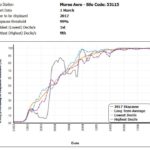Helicoverpa are the primary insect pest of chickpeas. Beneficial insects that are present in many crops do not thrive in chickpeas, so successful helicoverpa management relies heavily on monitoring and identification, appropriately timing control to crop stage, and using the recommended thresholds.
Monitoring involves regular in-field checking with a beat sheet. Additionally, moth numbers can be monitored using pheromone traps (see the video on how to set them up).
The Department of Agriculture and Fisheries maintains a network of traps from August-November, part of a national helicoverpa monitoring effort (see Table 1).
Why bother to monitor helicoverpa using pheromone traps?
In regions where Helicoverpa armigera are more prevalent (generally north of Dubbo), one of the key questions about early spring infestations is the relative proportion of H. armigera (corn earworm, cotton bollworm) and H. punctigera (native budworm) present in the populations. Whilst H. punctigera is susceptible to all registered insecticides, H. armigera is resistant to the older products (synthetic pyrethroids and organophosphates), and treating a resistant population can result in a spray failure. The reduced efficacy of these products can be masked when treating low densities e.g. just above the threshold of 2-3/sqm. For example, if resistance reduces a pesticide’s efficacy to 70%, a spray applied to 4 larvae/sqm will reduce the population to below threshold. However, if the initial population was 15 larvae/sqm, 4.5 larvae/sqm would remain in the crop – still above the threshold.
H. armigera in crops this early– is that normal?
The proportion of H. armigera entering diapause in March–April varies between seasons, depending on the temperatures experienced. This autumn was relatively warm, so a higher proportion of pupae have not entered diapause and continue to develop slowly through winter, emerging in late winter as temperatures warm up. The graphs in Figure 1 show how much lower than average the predicted percentage of diapausing pupae were in four different regions (Lachlan, Namoi, Gwydir, and Darling Downs) during March.
- Hillston
- Mullaley
- Moree
- Dalby
Figure 1. CottAssist-generated comparison of 2017 rate of diapause induction (% pupae entering diapause) with long term averages (coolest/warmest years, long term average). 2017 data is represented by the black line which dips to the lowest % during March (click on a graph for a larger image).
Using pheromone trap data to inform management decisions
- Moth trap data is no substitute for crop checking. Moth traps are indicators of the presence of adults only, not an actual count of larval pest pressure in your paddock.
- The presence of moths in the traps means there are moths in the district. If there are H. armigera in the traps, you can assume there will be a certain proportion of H. armigera in your crops. However, the relative numbers of H. armigera and H. punctigera in the traps is not a good indicator of the proportion of H.armigera and H. punctigera larvae in the crop as there are a number of factors that influence egg laying and egg/larval survival.
- Peaks in moth trap catches are good indicators of periods of high moth activity. These could be caused by influxes, emergence from diapause and/or warm nigh time conditions suitable for moth activity. There is currently no available research correlating moth trap catches and larval numbers in chickpeas. Consequently, we don’t know what numbers of moths are likely to result in larval densities above the economic threshold (see Economic Threshold Calculator). A low number of moths would be <20/week, and a very high number 500-1000 moths/week.
- If you’re north of Dubbo: ignore the moth trap data this season and assume there are H. armigera in the crop. Plan your crop monitoring and make your management decisions accordingly.
Key points to remember when managing helicoverpa in chickpeas
- Consider crop stage. Helicoverpa cannot cause crop loss if there are no pods. Spraying during flowering, before pods are set is of no benefit in protecting the crop from loss.
- Consider pest stage. Helicoverpa larvae will feed on leaves (not flowers or buds) until they are medium size (>7 mm). Medium and large larvae in the crop during flowering may complete development before the crop sets pods.
- Consider environmental conditions. If frost is predicted, helicoverpa numbers are over threshold, and there are minimal pods per plant, delay the spray and check to see if the pods have survived the frost.
In most years, one spray during podding will be sufficient to control helicoverpa and prevent crop loss. The longer you delay the first spray, the less likely it is that you will require a second spray.
Use a beat sheet to assess the number and size of larvae in the crop (see a demonstration in this how-to video).
If you need a refresher on larval size:
|
Instar |
Size category |
Length of larva (mm) |
Notes |
|
1 |
Very small (VS) |
1-3 |
High natural mortality |
|
2 |
Small (S) |
4-7 |
|
|
3-4 |
Medium (M) |
8-23 |
|
|
5-6 |
Large (L) |
24-40+ |
Cause 80% of feeding damage |
Use the threshold calculator to check what threshold is appropriate for your estimated cost of control (+ application) and grain value.





